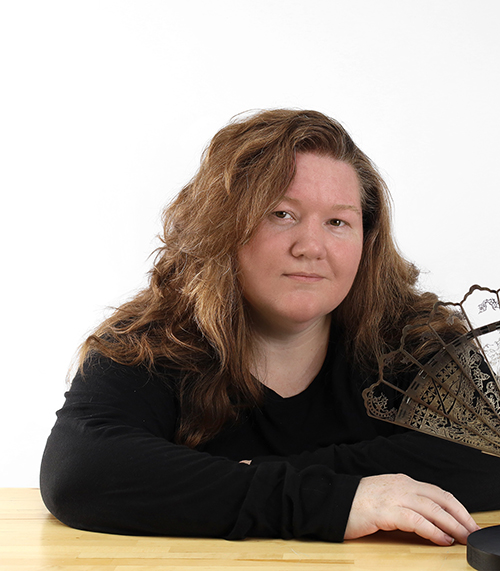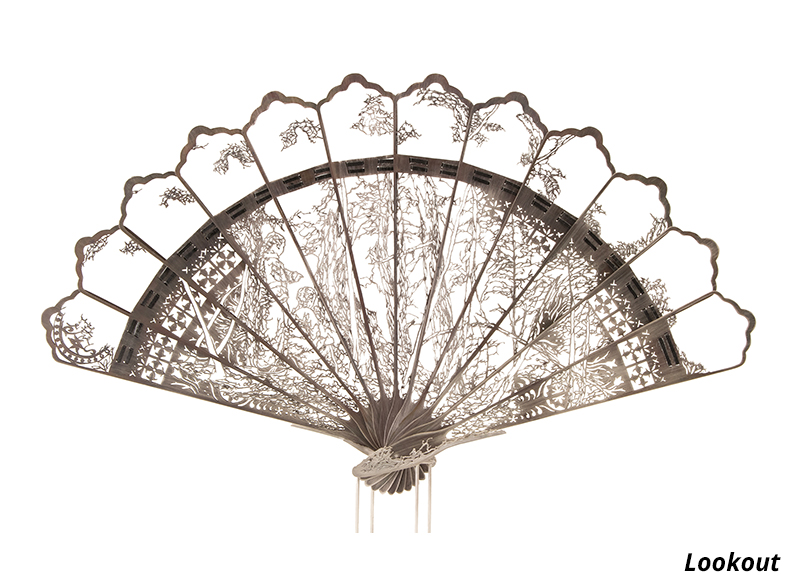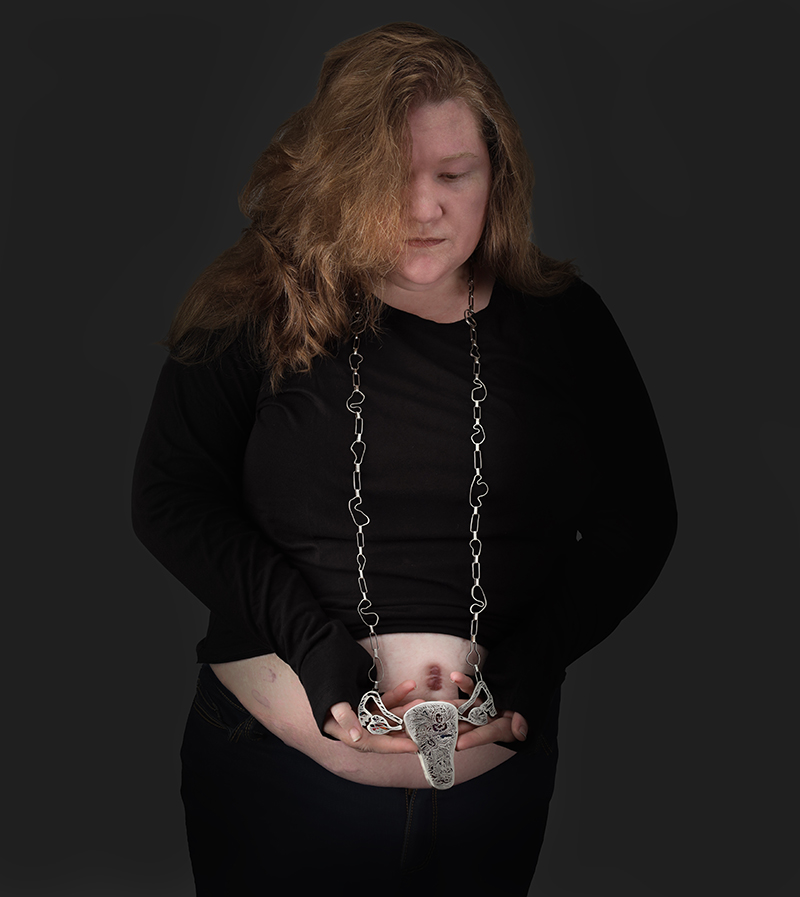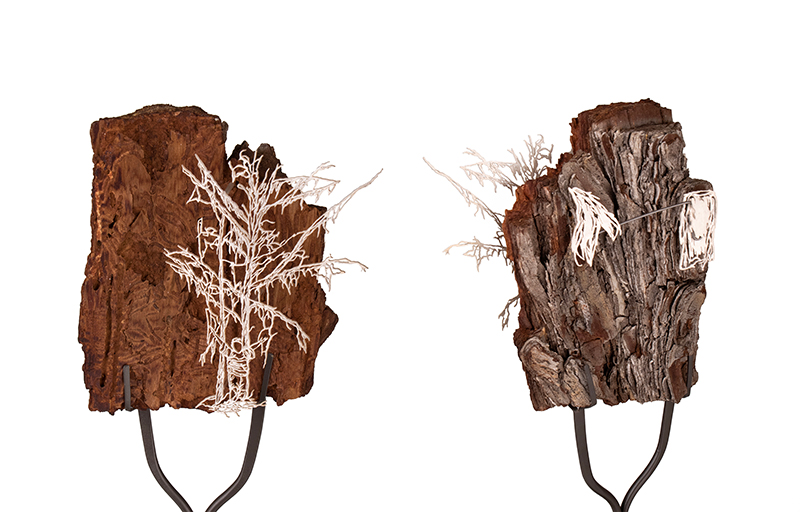
How did you get started as an artist?
I grew up in a conservative rural area in West Texas in a large family of creative and talented people. My influences started with the traditional skills that my grandmother and mother exhibited in sewing, knitting, and crochet. There was always a sense that even when means were limited, you could create or change something to express your aesthetic, whether clothing, practical-use items, or your living environment.
My dad owned a small, custom t-shirt and awards business, where I would sometimes build trophies and help sell t-shirts at events. It was something I took for granted at the time, but looking back, this was instrumental in growing up with the understanding of processes behind the scenes of manufacturing, hand-assembly of complex objects, and having the means to create something customized for others. I began to see how people valued individuality, and the personalized expression that could be created through simple changes to adornment.
My siblings and cousins were also major influences in my life, many pursuing musical or visual creative outlets and careers. Their talents showed me a different approach to the world, but fear of inferiority left me hesitant to pursue any artistic skills I might also have had as a teenager. However, I began sketching on my own during my last years of high school, practicing portraits of my friends and classmates. I took my first art class as a college student several years later while pursuing a degree in education. It wasn’t long before I realized that art-making needed to be a part of my life and future, and I began to slowly take steps towards that goal. I eventually ended up at another area University to pursue a degree in the arts where my interests shifted from painting and drawing to include metalwork and object-making.

Recognizing differences in individual experience has become a vital part of my world view and inspires me daily
In my first metalsmithing class, I fell in love with the jeweler’s saw. With my roots in 2-D, I felt the Jeweler’s saw was an alternative drawing utensil that I could use to carve away material in intricate ways to create images and surface design. I learned I could use this method to create objects that translated sketches and drawings into metal. Eventually, I pursued an MFA at the University of Iowa, where I pushed my skills both technically and conceptually while also expanding my world view and connecting more to myself as an individual.

Each medium and process has strengths and limitations, and in metalsmithing there must be a constant conversation between materials, process, and functionality
What themes does your work involve?
My work involves themes of self-discovery; neurodivergence and health; and interactions between humans and others, objects, and place.
My mind works overtime to constantly create connections, to make sense of my experiences, and reframe memories in the context of their present influence on my life. Often this manifests as crippling self-analysis. I started making work to document the connections I was making across time and experiences to externalize some of these ideas, make them concrete, and process grief and trauma in a lasting way.
As an adult, I began to identify with multiple forms of neurodivergence, again leading me to reframe my thought patterns and personal experiences through this lens. Many days, my thoughts race and I’m desperate to catch fleeting moments and impressions. I am sensitive to the body language and tone of those around me, so relationships are in a constant state of flux as my empathy works overtime to understand and relate to the challenges of others. This heightened state of observance contributes to a state of chaos in my internal life that others may not experience, which is really fascinating.

As an extension of this, my perception of the place is rendered though a system of connections and context. The history of a location, what led to its current state, the decisions made by humans combined with entropy of natural forces, and the push and pull of the natural and man-made. The stories we tell ourselves about a place, an object, or a person are so integral to how we value it. Often, I am creating artwork that presents a contextualized personal narrative, but ultimately invites the viewer to use their personal context to create a new story.
What is your source of inspiration?
I am inspired by nature, memory, and individuality.
After growing up in a family system that emphasized religious group identity and values, recognition of individuality has become one of the most important concepts in my adult life. In nature, no two flowers are the same, no two leaves have the exact same vein pattern, no two plant species have the same exact needs, and growing a same species of plant in different places or conditions can result in vastly different outcomes. This also applies broadly to human experience, with the understanding that while we can control some factors in our lives, many of the elements that contribute to outcomes in life are vastly beyond our control. Recognizing differences in individual experience has become a vital part of my world view and inspires me daily. I want my artwork to reflect uniqueness, and the outcomes of never having full control of a process.
Can you describe your creative process?
My creative process often revolves around the intersection of materials, imagery, and technical exploration. Each medium and process has strengths and limitations, and in metalsmithing there must be a constant conversation between materials, process, and functionality. For example, my strong interest in replicating mark-making can push the limits of what metal can do. While metal is strong, as I create thinner and more precise lines, weakness and fragility still become factors. The knowledge that a design will someday be worn creates an imperative for designing a support system, or a solid definite edge that won’t get caught on skin, hair, or clothing. So my next step is often trying to envision a way to not only create delicate designs, but protect them. I am always experimenting with these intersections, trying to see the extent to which I can push the boundaries of material.
In early concept stages, there is some level of experimentation and play. I will often conceive of a design, and then make several small-scale variations to explore the process. These experiments often become jewelry or sellable pieces, and they help me problem solve and show me the variables I will have to work within the completion of larger conceptual work or statement pieces.
When I start to tackle the final version of a piece, I can use that new technical knowledge to enhance my sketches or ideas. It’s important to have a plan for the entire process, but always leave myself room for variation and “happy” accidents. The bulk of the time is spent in my studio with the jeweler’s saw then heat-based process of soldering, working carefully not to melt any of the piercing work. After that, is cleanup and finishing.
Once I am satisfied with the shape and finish of the piece, I often chemically treat the surface of the metal using a patina called liver of sulfur. At cold temperatures, this patina changes the colors in the metals surface in ways that are completely unpredictable, but my goal is to embrace the color variations and decide when to stop the chemical reaction when the colors are dark enough to create surface contrast.
In the end, my process alternates acts of precision with those of improvisation, resulting in unique, non-perfect outcomes.
Do you have any artistic goals for the future that you would like to share?
Right now I’m in the process of developing a series of work that reflects on the radical hysterectomy I had in 2020, following a diagnosis of endometrial cancer. In the years after this surgery, I experienced many challenges in coping with surgical menopause, mental health issues, and recognition of previously undiagnosed neurodivergence. I’ve been thinking a lot about the removal of organs that define womanhood in American society, the broad definitions of gender affirming care, and my own gender identity in the context of my upbringing in a religious and conservative environment. This body of work uses imagery from childhood photographs to reexamine the traditions I grew up with by externalizing the organs that predetermined a path of expectations I did not travel.
My eventual goal is to exhibit this body of work that reflects my personal story of trauma, loss, and ongoing self-discovery.


